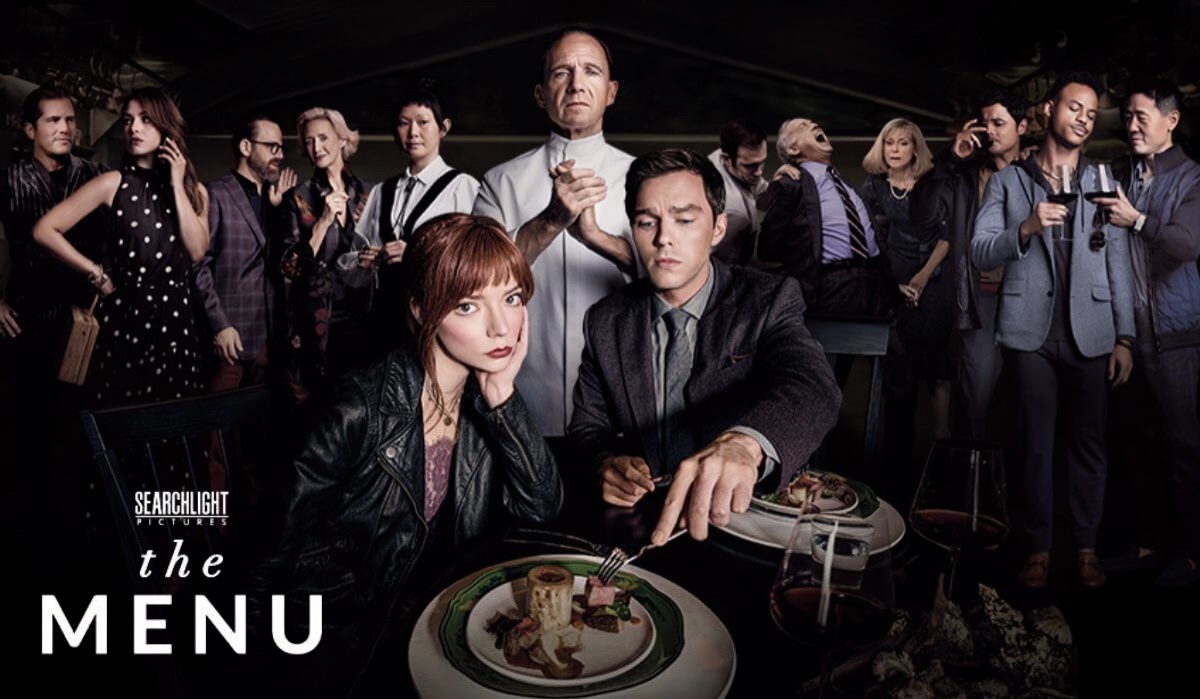The Menu—a revelation on celebrity chefs
The film’s chilling plot twists reveal shocking similarities to modern food entertainment.
The Menu (2022) opens with a scene at a port, where our protagonist Margot (Anya-Taylor Joy) smokes a cigarette beneath a pillar. Her date, Tyler (Nicholas Hoult), promptly tells her to stop, as it will “ruin her palate.” After some bickering, she puts out her smoke and the two proceed to observe a cast of archetypically-rich characters board their boat. The group includes an irrelevant movie star (John Leguizamo) and his personal assistant (Aimee Carrero), a stuffy food critic (Janet McTeer) and her lapdog editor (Paul Adelstein), a wealthy married couple (Judith Light) (Reed Birney), and a squad of haughty finance up-and-comers. The ship takes them all to a remote island, where they’ve paid thousands for a multi-course, gourmet meal.
Ralph Fiennes portrays the world-famous Julian Slowik, a celebrity chef with a hardcore philosophy comparable to figureheads such as Gordon Ramsay, Jamie Oliver, and Bobby Flay. Slowik and his devoted head server, Elsa (Hong Chau), host a meal on the island. The night begins as expected, but quickly takes a sinister turn with a jarring death. It becomes clear that Slowik’s plan during the dinner involves killing everyone. In cult-leader fashion, Slowik testifies his depravity over the fine dining industry, echoing explicit Marxist sentiments about the nature of kitchen work. He expresses his disgust towards “commodity fetishization”—a term Marx used to describe the phenomenon of consumers valuing products without considering the work used to produce them—in the fine dining industry.
The commentary on customer service in the film will ring true for any current or former restaurant employees. Even in today’s society, restaurant employees face some of the most strenuous working conditions. Kitchen staff are often expected to work through injuries, and most employees are expected to work on their feet, without a break, for shifts over ten hours long. Such concepts are reflected throughout the film’s plot, as the kitchen staff and servers all live together in a cramped hut, dedicating all their time and energy to the restaurant.
As the dinner grows more tense, Slowik scrutinizes his wealthy diners for the state of the industry, but also turns blame on himself. Each dish served in the film is symbolic and serves as a message for the diners and for viewers. A meal that stood out to me was titled “The Man’s Folly”—a representation of the “sexual advances” that Slowik had made towards a female chef in his kitchen.
The restaurant industry is a male dominated business. While many think the opposite—as cooking is often stereotyped as a female profession—the toxic, hyper-male environments in kitchens have driven many females in the food industry to be subject to sexual harassment.
The dynamic of fine dining portrayed in the film may be unfamiliar to some viewers. However, this same audience can easily relate to the conflicts within The Menu, as all of these issues are magnified through the presence of food entertainment. In a scene in The Menu, a guest is invited back to Slowik’s kitchen to cook under intense scrutiny and a timer. The intense countdown made me think of shows like Chopped, where cooks scramble to plate their food for a panel of judgmental chefs. The movement of cooking shows from homely instructional daytime shows to strenuous competitions monitored by macho celebrity chefs reflects the different, seemingly contradictory images of cooking in North American culture.
According to Slowik’s several monologues, The Menu is a film about the corruption of fine dining and cooking culture—although his character is partially to blame. He seeks to solve media-driven issues with a cult mass-murder-suicide, but in doing so only further reveals the entrenched power structures within modern kitchen cultures. His position only provides him with authoritarian power. In spite of his constant spiels on Marxist ideals of worker equality, Slowik only uses this rhetoric to further entrench his restaurant’s power structure. Ultimately, the only victory in the film is held by Margot, who walks out alive with a cheeseburger and fries to-go, reminding the audience of food’s true purpose: it is meant to be eaten.
Associate News Editor (Volume 49) — Emily is a third-year at UTM, studying Environmental Science and Political Science. Her academic career is best illustrated by terminal indecisiveness between the humanities and sciences. As a passionate writer, she looks forward to igniting her own creativity for The Medium and hopes to learn from others and grow in her work. Aside from speed typing thousands words worth of analyses, essays, and articles, Emily enjoys spending her spare time running miles through the woods, assembling the perfect outfits, reading on public transit, and drinking copious amounts of coffee. She can be found on Instagram and LinkedIn.


